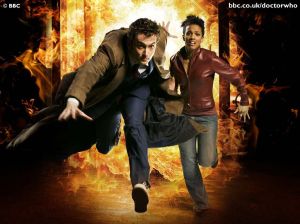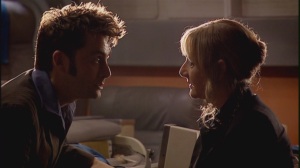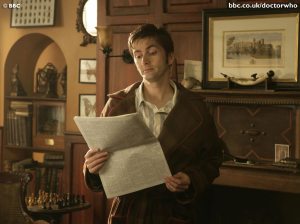jason stives gives us a crash course in one of the most popular tv series in British history …
When it comes to an overall reputation, science fiction is always muddled by its own stereotypes. Vulcans, light sabers, star cruisers — these are all words associated with the genre, and the overall tendencies of their fans to do very geeky things has always made it especially difficult for mainstream audiences to look past any space opera aspect of science fiction.
The British TV import Doctor Who has the dubious honor of being hit by a reputation as far as mainstream exposure. The show, which is in the Guinness Book of World Records as the longest-running science-fiction series in the world, is highly acclaimed yet dogged by having a low-budget past. The show, which has aired in some format for almost 50 years, use to be run on a shoe string budget with cheap special effects and wobbly sets. But in 2005, when the show was given a million-dollar make over, it has since become a monster hit around the world all over again. Case in point, besides bringing in big numbers for BBC America in 2010, it was the number three best-selling TV series on iTunes behind Mad Men and Glee.

The premise of Doctor Who is both simplistic yet highly creative when you explore the mystery of the show’s main character. It tells the tale of a time-traveling 900-year-old alien known only as the Doctor, who travels across the universe fighting alien forces and visiting numerous planets and various time periods with different friends he picks up along the way. The Doctor is a Timelord, a race believed to be the creators of time travel and the oldest race in the universe. His ship is called the TARDIS (stands for Time And Relative Dimensions In Space) and can go anywhere in the universe at any point in time while taking any shape to help blend in with its environment. Due to circumstances established in the first story that was broadcast, the TARDIS is stuck in the shape of a 1950s London Police Box.
One of the reasons for the show’s longevity, and one that reinforces the creative possibilities of science fiction, is the idea that the Doctor can change his appearance, allowing a new actor to be cast in the part with no issue. When William Hartnell, the actor who played the First Doctor from 1963 to 1966 became very ill, the producers of the show turned to the character’s alien roots to create a way to recast the character without alienating the audience. Since the Doctor’s mystery was a heavily kept secret, the idea of regeneration was instituted, being that since he was an alien, if the Doctor was close to death or severely hurt, he could renew himself and repair his body, but in the process change his appearance and whole personality. This provided any actor to take the role the opportunity to put their own spin on the character and has been a devise used on eleven occasions during the shows lengthy run.
The show first aired on November 23, 1963, the day that in England news broke about the assassination of President John F. Kennedy. In England, Doctor Who became an institution in the same vein of Robin Hood and Sherlock Holmes, a purveyor of truth and fighter against evil. Throughout the ’60s and ’70s, the show was a ratings juggernaut and the most sought after part on British television. Eventually it developed a cult following stateside during the late ’70s, thanks to the popularity of the Fourth Doctor, Tom Baker, a man who until recent years was considered the best incarnation of the famous Timelord. However, in the ’80s, interest in Doctor Who waned in part because of sci-fi blockbusters like Star Wars and big-budget television shows like Star Trek: the Next Generation. Compared to these, Doctor Who seemed dated and a thing of the past, and in 1989, the show was canceled after an impressive 26-year run.

Various attempts were made to resurrect the series, including numerous attempts at a feature film. The only glimmer of hope during the next 16 years came with a television movie produced by Fox and Steven Spielberg’s Amblin Entertainment that served as a backdoor pilot for a potential American/U.K. co-produced show. Doctor Who: The TV Movie aired in May 1996 and, while very successful in England, it performed poorly stateside as it was aired the same night of the finale of Roseanne. Progress on another show would remain predominantly quiet until 2003, when on the eve of the shows 40th anniversary, BBC Wales announced that Queer As Folk creator Russell T. Davies would helm a new-version Doctor Who to be aired in the spring of 2005.
With actor Christopher Eccleston (Destro in G.I. Joe: The Rise of Cobra) in the role of the Ninth Doctor and former British pop singer Billie Piper as his companion Rose, the show relaunched on March 26, 2005 and became an instant success. The show’s first season back was a complete success, but it wasn’t until David Tennant took over the role, after Eccleston bowed after one season, that the show reached new heights of popularity and garnered great exposure on American cable television, thanks to BBC America and the popularity of the show’s more adult-oriented spin off, Torchwood. Tennant’s Tenth Doctor became the face of the show around the world and for almost five years made the show one of the most watched shows on British television and one of the best science-fiction series in the world.
Now heading into its sixth series, the new season — which debuts on April 23 on BBC America — will be the second season for the 11th Doctor, Matt Smith, who at 28 is the youngest actor to play the part.
To close this beginner’s guide for new Whovians, here are 10 episodes of the revised series to watch get the best grasp on show. While I would recommend episodes of the original series, unless you are willing to look passed the cheesy special effects and wobbly sets, its best to start with the slicker, cooler and even better version of this television institution.

10. Rose: The story that started the now very successful relaunch in 2005. Rose Tyler, the observational hero of the episodes title, is your average teenager at a crossroads in her adolescent life. She lives with her mother, has a boyfriend she loves, and works in a dead end job at a department store, as she quips later in the episode she has no job, no hope, and no future. Until the one night she stays late at work only to see shop window dummies come to life and attack her. When it seems like curtains, a mysterious figure known only as the Doctor saves her and changes her life forever … or at least for the next two seasons.

9. Vincent And The Doctor: While this gem only aired last year, “Vincent And The Doctor,” much like its subject matter, is a confused work of art. When the Doctor and Amy find something evil lurking in the background of one of Vincent Van Gogh’s famous paintings, the duo leap into action traveling back to the months leading up to the famous painter’s tragic death to find the source of the problem. In many ways, it’s a simple story with no weight in its resolution, but it succeeds in tackling the subject of changing a life when a path is already chosen. Famed writer Richard Curtis (Love Actually, Bridget Jones Diary, Blackadder) brings his unique blend of drama and comedy to the forefront, giving a light-hearted tone to the Doctor’s pursuit of the dark muse in Van Gogh’s foreground but grounds the story in reality by addressing the subject of depression without any sci-fi/fantasy blinders.
8. The Unicorn And The Wasp: Showcasing a great blend of British humor and mystery, this story featuring the Doctor and his season-four companion Donna Noble is all about fun and intrigue. With the backdrop of an Agatha Christie mystery, and Agatha Christie herself, the Doctor and Donna set about solving the murder of a professor amongst a posh 1920s dinner party where anything human and non-human can be deemed a suspect.
7. School Reunion: For new fans unfamiliar with the show’s original run, “School Reunion” presents a dip into the past by presenting the audience with some of the Doctor’s former counterparts from the ’70s. While investigating some strange occurrences at a local grade school, the Doctor comes back into contact with Sarah Jane Smith, a journalist and the Doctor’s longest serving companion. While all good on the surface, Sarah still harbors some missed feelings for her best friend, leaving Rose to question her own life with the Doctor.

6. The Eleventh Hour: Matt Smiths inaugural episode as the 11th incarnation of the Doctor is really, really fast. In 60 minutes, much of the traditional things showcased after the Doctor’s regeneration are pushed aside to re-establish his position as a man who can save the world in less than 20 minutes. With so much to establish, the introductions of both the new Doctor, his new, red headed companion Amy, and a new story arc, “The Eleventh Hour” is fun, thrilling, and over a bit too soon.
5. Midnight: Former head writer and executive producer Russell T. Davies was always a sore spot for abuse from loyal fans of the show. While they were forever grateful for him reviving the dormant show, Davies’ penchant for sexual innuendos and groaner-like moments in his self-penned stories always left a black eye on the fans. “Midnight,” aired during the shows fourth season, changed that belief. The Doctor takes a trip on star cruiser with only a handful of other passengers on board. When a mysterious force inhabits one of the crew members, and with no one to back him up, the Doctor is the prime reason for the peril that is eclipsing the crew of the space bus. The great thing about “Midnight” is it has no resolution. Whatever the problem is, it’s never solved, and any damage done is left unfixed for good or for worse. No big special effects, no monster of the week — just paranoia and trust issues for the Doctor.

4. Human Nature/Family Of Blood: Fan biased here, but this story has always been my personal favorite of the revived series. Originally a novel featuring the seventh Doctor in the mid-’90s, its writer, Paul Cornell, was gracious enough to adapt it into this exhilarating two-parter. The Doctor and Martha are pursued by an alien force, and with very few options, the Doctor takes the drastic task to duck out of sight and make himself human until the aliens have disappeared. What really makes the story so captivating is David Tennant’s performance as the human John Smith. Like turning off a light switch, Tennant goes from times champion to the average human being trying to belong in the world. Watch carefully when he realizes that he as John Smith isn’t real and that he must sacrifice a life of love and happiness to save the universe alone.
3. Bad Wolf/The Parting Of Ways: For those unfamiliar with the regenerative process of the Doctor, the Ninth Doctor’s swan song is a perfect example. The concept is both frightening and uplifting, and Chris Eccleston’s exit from the show acts as a guiding light to the aspects of change in the world of Doctor Who. The thrill of watching this story is wondering when it will come, and when it doe, it’s still awe inspiring.
2. Dalek: Let’s face it: One look at the picture below, and a Dalek, the Doctors arch nemesis, seems silly to today’s audience. But in the post-war world of ’60s England, the Daleks were just as threatening to audience as the Nazis. Dalek reintroduces these evil pepper pots and re-establishes the menace they held for three generations of TV viewers. The threat of a loan Dalek, underground in the Utah dessert, brings fear to the Doctor and anger to what its existence means to the events of his past.

1. Blink: When people ask me why I love Doctor Who, I normally point them to this episode. While I grew up watching VHS copies of the original series, for those not open to the low-fi nature of the original show, “Blink” is the exact reason the show is a wonderful piece of television. Featuring future Oscar nominee Carey Mulligan (An Education), this episode features very little of the Doctor and instead focuses on the effects of the Doctor’s existence in the life of just another human when an alien force crosses paths with our world. It’s thrilling, it’s frightening, its Doctor Who as it should be viewed and treated.
All Photos Credit: BBC


